
Die heutige Flagge Perus wurde am 25.02.1825 eingeführt. Sie zeigt drei senkrechte Streifen in Rot, Weiß und Rot. Die Nationalflagge zeigt zusätzlich den Schild des Staatswappens in der Mitte des weißen Streifens. Die Marineflagge zeigt an dieser Stelle das vollständige Staatswappen. Das Rot steht für das Blut, das für die Unabhängigkeit vergossen wurde, Weiß für Frieden und Gerechtigkeit. Die Farben der Flagge sind nicht per Gesetz festgelegt. Der Farbton des Rot scheint aus der Praxis heraus definiert zu sein, und zwar als Pantone 485. Die Farben gehen auf den argentinischen Generalkapitän José de San Martín (1778–1850) zurück, der im Jahre 1820 die Befreiung Chiles und Perus von der spanischen Herrschaft einleitete. Er erblickte einst eine Schar Flamingos mit roten Flügeln und weißer Brust, die über seine Soldaten der peruanischen Legion hinwegflogen, und sah darin ein günstiges Vorzeichen für seine Unternehmungen. Er wählte die Farben dieser Vögel für die Flagge seiner von Chile aus operierenden Truppen, und wenig später war sie auch beim Volk sehr beliebt. Sie war zunächst diagonal zwischen Weiß und Rot geteilt und zeigte in der Mitte ein Wappen mit der über den Anden aufgehenden Sonne. Im Jahre 1822 zerstritt sich José de San Martín mit dem von Norden her in das Land eindringenden Simón Bolívar (1783–1830) und verlies 1824 das Land. Möglicherweise erließ der Marquis José de Bernardo Torre-Tagle deshalb am 15.03.1822 ein Dekret, in dem die Flagge in ihrem Aussehen mehr der Flagge Argentiniens (La Plata) angeglichen wurde. In diesem Land hatte José de San Martín seinen Befreiungskampf begonnen. Die Flagge zeigte jetzt drei horizontale Streifen in den Farben Rot, Weiß und Rot mit einer strahlenden Inkasonne in der Mitte. Im gleichen Jahr (nach anderen Quellen erst 1823) wurden die Streifen jedoch senkrecht angeordnet um Verwechslungen mit der Flagge Spaniens zu vermeiden. Nach den Siegen über die Spanischen Truppen im Jahre 1824 wurde am 25.02.1825 beschlossen, die Inkasonne von der Flagge zu entfernen und durch das Schild des Staatswappens von Peru zu ersetzen. Die Flagge von Peru ist seit 1825 unverändert in Gebrauch, lediglich zwischen 1836 und 1839 unterbrochen, als Peru mit Bolivien eine Föderation bildete. Die Föderation hatte eine eigene Flagge. Sie war rot bzw. purpur und zeigte in der Mitte nebeneinander und von einem grünen Kranz umgeben die Wappen von Peru und Bolivien, oberhalb von einer Inka-Sonne dominiert. Bolivien behielt zusätzlich seine eigene Flagge. Peru wurde in Nordperu und Südperu geteilt. Nordperu verwendete weiter die bisherige Flagge von Peru, Südperu bekam eine eigene Flagge. Sie war horizontal grün-weiß gestreift und zeigte einen breiten senkrechten roten Balken am Mast, in dessen Mitte eine goldene Inkasonne platziert war, mit vier goldenen Sternen darüber. Sie standen für die vier Provinzen, aus denen Südperu gebildet wurde.
Quelle:
Flaggen Wappen Hymnen,
Flaggen und Wappen der Welt,
Die Welt der Flaggen,
Wikipedia (EN),
Volker Preuß


Wappen von Peru,
Quelle, nach:
Corel Draw 4

Das Staatswappen von Peru wurde, wie die Flagge, am 25.02.1825 eingeführt. Das Schild ist durch goldene Linien halbgespaltenen und geteilt. Das erste Feld zeigt ein Vikunja-Lama. Es steht für die Tierwelt des Landes. Das zweite Feld zeigt einen Chininbaum. Er repräsentiert die Pflanzenwelt. Das untere Feld zeigt ein Füllhorn. Es steht für die Bodenschätze des Landes.
Quelle:
Flaggen Wappen Hymnen,
Flaggen und Wappen der Welt,
Die Welt der Flaggen,
Wikipedia (DE),
Volker Preuß


Flugzeugkokarde,
Quelle/Source, nach/by: Wikipedia (EN)

Flugzeugkokarde für Marineflieger,
Quelle/Source, nach/by: Wikipedia (EN)

Lage:
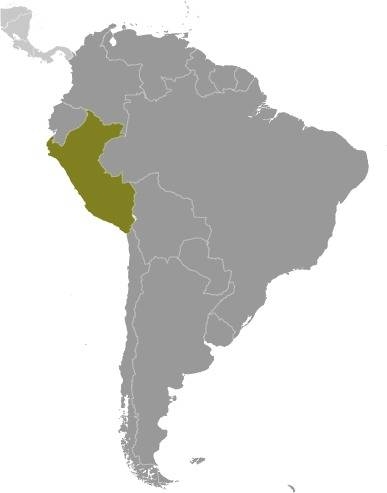
Quelle/Source: CIA World Factbook
Landkarte des Landes:
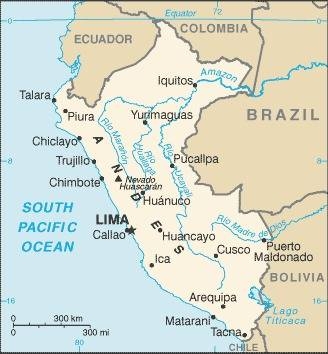
Quelle/Source: CIA World Factbook

Fläche: 1.285.216 km²
Einwohner: 32.800.000 (2020), davon 60 % Mestizen, 26 % Indianer (Ketschua, Aymará), 6 % Europäer, 3 % Schwarze, 1 % Asiaten
Religionen: 76% Katholiken, 14% Protestanten, 4% andere Christen, 5% Nicht-Religiöse
Bevölkerungsdichte: 26 Ew./km²
Hauptstadt: Lima, 8.574.974 Ew. (2017)
Amtssprachen: Spanisch, Ketschua, Aymará
Währung: 1 Sol (PEN, S) = 100 Céntimos
Zeitzone: MEZ – 6 h
Quelle:
Wikipedia (D)

1250 v.Chr.–200 n.Chr. · Herausbildung lokaler Stammeskulturen (Chavin, Cupisnique, Gallinazo, Moche, Nazca, Paracas)
1250–1450 · Herausbildung der Inka-Kultur um die Städte Machu Pichu und Cusco
1450–1530 · die Inkas erobern das gesamte Gebiet zwischen Äquator, Anden, Pazifik, und dem Kap Punta Lavapié im heutigen Chile
1531–1533 · das Reich der Inka wird von dem Spanier Francisco Pizarro erobert, Pizarro wird Statthalter und Gerneralkapitän von Peru
1535 · Francisco Pizarro Marqués de los Charcas y de los Atabillos gründet Lima
1541 · Ermordung des Francisco Pizarro
1543 · Errichtung des spanischen Vizekönigreichs Peru (ganz Südamerika außer Portugiesisch-Brasilien)
1739 · Errichtung des Vizekönigreichs Neugranada (heutiges Ekuador, Kolumbien, Panama, Venezuela) durch Abtrennung von Peru
1776 · Errichtung des Vizekönigreichs Río de la Plata (heutiges Bolivien, Paraguay, Uruguay, Nordargentinien und Rio Grande do Sul) durch Abtrennung von Peru
1780 · Aufstand der Indianer unter Tupac Amarú, dem letzten Inka
1810 · Beginn des anti-spanischen Freiheitskampfes in Südamerika (Kolumbien, Venezuela, Argentinien ...)
14.05.1811 · Proklamation der Unabhängigkeit von Spanien, Peru bleibt jedoch loyal zu Spanien
1820 · der Freiheitskämpfer José de San Martín – er hatte 1817 die spanische Herrschaft in Chile beendet – greift Peru von Süden her an
28.07.1821 · José de San Martín erobert Lima, Proklamation der Unabhängigkeit von Spanien
1822 · der Freiheitskämpfer Simón Bolívar – er hatte 1819 die spanische Herrschaft in Kolumbien endgültig beendet – greift Peru von Norden her an
1822 · José de San Martín und Simón Bolívar zerstreiten sich in der Frage "Monarchie oder Republik", um einen Bürgerkrieg zu vermeiden geht San Martín 1824 nach Frankreich ins Exil
1824 · Niederlagen der spanischen Truppen gegen Truppen von Simón Bolívar in der Schlacht von Junín und gegen Truppen seines Stellvertreters General Antonio José de Sucre in der Schlacht von Ayacucho (09.12.1824), faktische Unabhängigkeit Perus
1824–1825 · Diktatur des Simón Bolívar
1825 · Oberperu trennt sich als Bolivien mit Simón Bolívar als Diktator von Peru ab
1827 · Simón Bolívar wird zum Präsidenten von Peru und Bolivien gewählt, Bolívar setzt einen Stellvertreter ein und geht zurück nach Großkolumbien wo er kurz darauf gestürzt wird
1828–1835 · Peru versinkt in Kriegen mit Bolivien, Ekuador, Argentinien und Chile, Bürgerkrieg
1835 · Invasion durch Bolivien, Ende der Anarchie
1835–1839 · Peruanisch-Bolivianische Konföderation
1879–1883 · Salpeterkrieg gegen Chile, Peru muss die Provinz Tarapacá sowie die Gebiete um Tacna und Arica an Chile abtreten
1929 · Peru erhält das Gebiet um Tacna von Chile zurück
1930–1933 · Diktatur des Obersten L. Sánchez Cerro
1933–1939 · Diktatur des Generals Oscar Benavides
1948–1956 · Diktatur einer Militärjunta unter Manuel Orída
1962–1963 · Diktatur des Generals Pérez Godoy
1965–1966 · kommunistischer Partisanenkrieg
1968–1975 · Diktatur einer Militärjunta unter General Alvarado
1975 · die Indianersprache Ketschua wird Amtssprache (neben Spanisch)
1981 · Beginn des kommunistischen Partisanenkriegs der Bewegung "Sendero Luminoso" (Leuchtender Pfad)
1992 · Festnahme von Guzman, dem Führer des "Sendero Luminoso"
1995 · Grenzkrieg mit Ekuador
1996 · Festnahme von Camilo Santos Vera, dem neuen Führer des "Sendero Luminoso"
Quelle:
Atlas zur Geschichte,
Weltgeschichte,
Wikipedia (D)

Der Name "Peru" geht auf das Wort "Biru" zurück, was in Ketschua – der Sprache der Inka – "Wasser" heißt. Ursprünglich war damit nur ein Fluss gemeint. Der Name wurde von den Spaniern auf das ganze Land übertragen. Die Inka nannten ihr Reich "Suyu".
Quelle: Handbuch der geographischen Namen


![]()

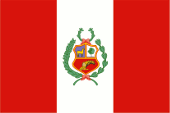


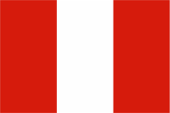


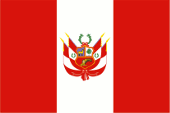
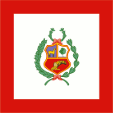
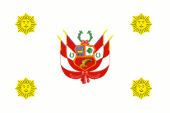
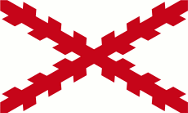

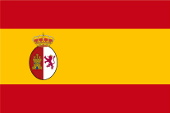
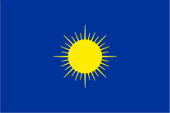
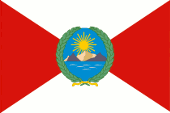
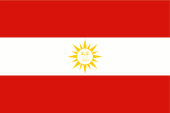
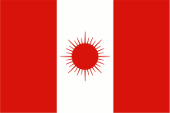





![]()
